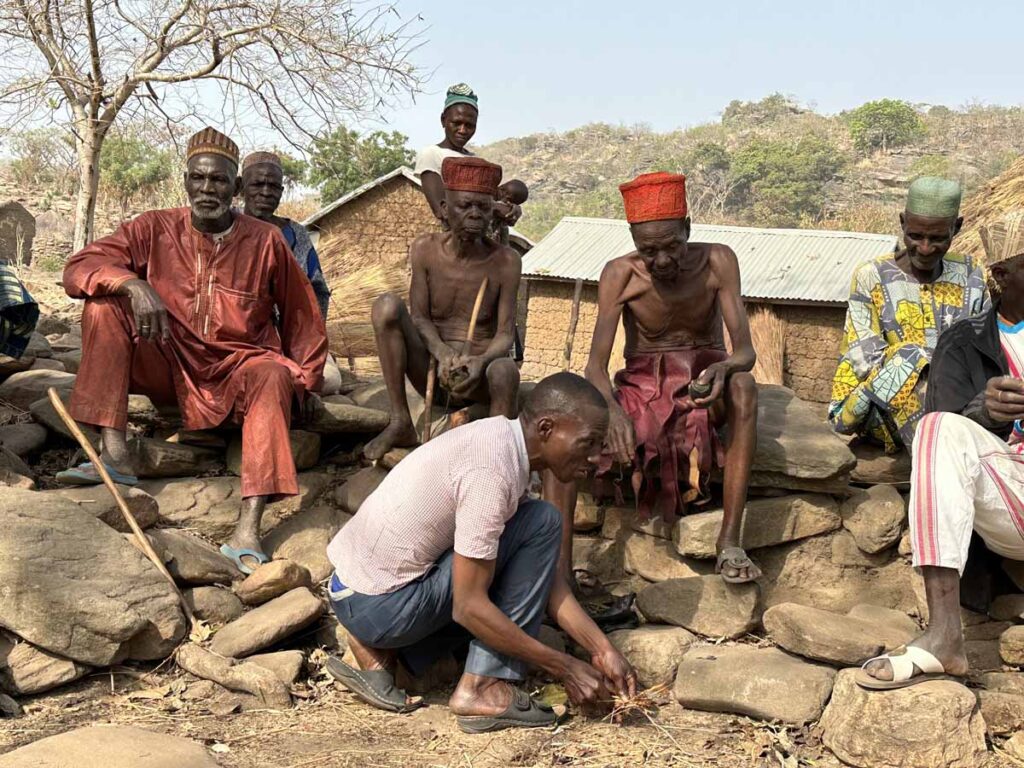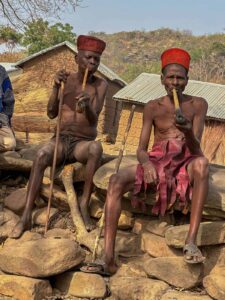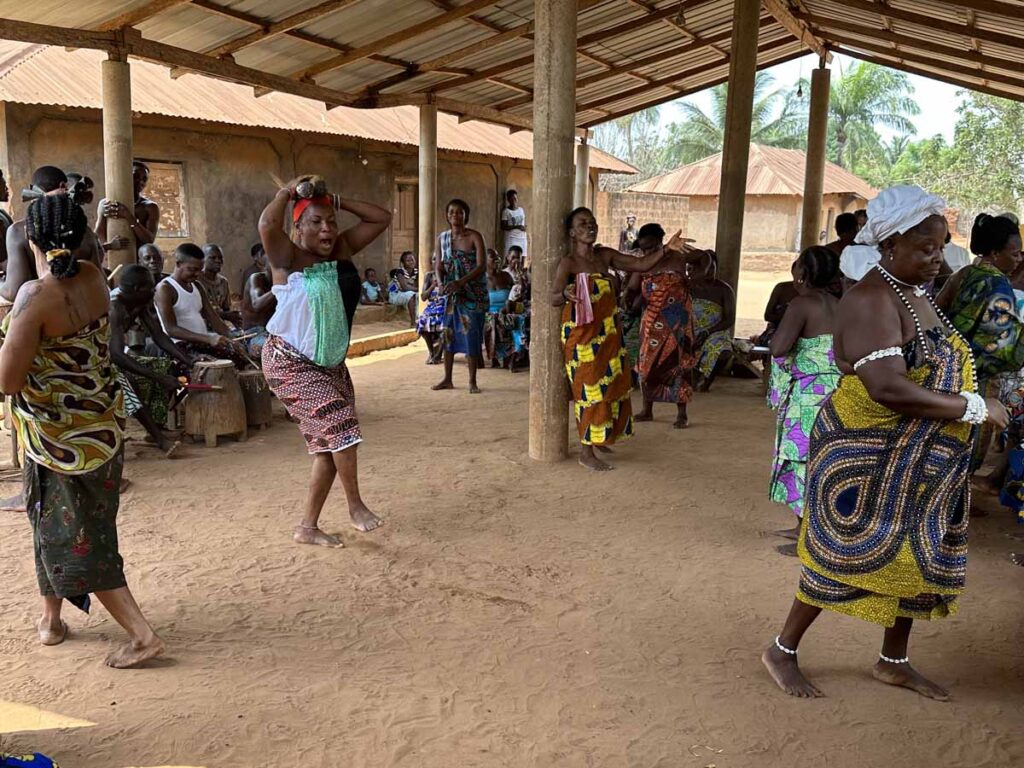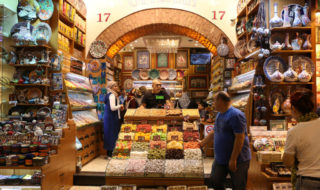West Africa has one of the most fascinating potpourri of cultures on the planet. Traditional and tribal culture still remains strong, as witnessed in vibrant village festivals held to honor local deities & dead ancestors. Not to mention the fact that Benin is the birthplace of voodoo, the animist religion practiced by many West Africans.
So, when a friend invited me to join her small group cultural tour to West Africa in January & February 2023, I jumped at the chance! I’ve been blessed to have visited Africa five times. Yet, like most travelers, I had only toured East Africa & Southern Africa. I truly love Africa – its beauty, the amazing sights, and especially the soul & spirit of the African people. I couldn’t wait to go back!
Our Cultural Tour of Ghana, Togo & Benin

Plus, our tour leader “Brother Noah” (photo, right) turned out to be fabulous. As an educated man who grew up in a small village in Togo and went through tribal initiations, Noah understands both the world of ancient tradition and that of modern Africa. We tour members (all 9 of us from California!) were the lucky beneficiaries of his incredible knowledge and life experience.
About This Blog Post – Highlights of West Africa
There were so many unique trip experiences to share with you, but I will highlight six in this blog post. We’ll visit a voodoo priest in a small village, attend two different & colorful dancing mask ceremonies, watch an incredible fire dance, visit a sacred voodoo shrine to make a wish, and witness dancers going into trances in a voodoo ceremony.

On this trip (and in further readings), I’ve learned a lot about the fascinating & complex subject of voodoo. So, today I want to help dispel some misperceptions about voodoo that many of us have – including me before the trip!
Quick Introduction to Voodoo
[First, a big thanks to the Lonely Planet “West Africa” guidebook for much of this information.]
Voodoo is not simple black magic, as most Western people think. In reality, it is a rich and complex religion which makes sense and gives order to the life of millions of believers. Voodoo is a life force, culture and way of life in sync with the natural world, something few people in our Western world can truly understand.

Traditional voodoo priests are consulted for their power to communicate with particular spirits and seek intercession with them. This communication is achieved through spirit possession and ritual that often involves a gift or “sacrifice” of palm wine or even animals, such as chickens or goats.
Beliefs and traditions can be complex, but several common factors are frequently found:
- The Role of the Natural World – Almost all traditional religions are animist, meaning that they are based on the attribution of life or consciousness to natural objects or phenomena. Thus, a certain tree, mountain, river or stone may be sacred because it represents, or is home to, or simply is a spirit or deity.
- The Role of Ancestors – In many African religions, ancestors play a particularly strong role – with a primary function to protect the tribe or family.
In West Africa, traditional or animist beliefs are strong. Even though the majority of people in Ghana, Benin and Togo are affiliated with Christianity or Islam, most still also practice their traditional beliefs.
Experience #1 – Visit to Fetish Priests in a Local Benin Village
One morning, we paid a visit to a small tribal village on a remote hilltop. This Taneka village is comprised of 3 different ethnic groups that came together in the distant past, most from neighboring Burkina Faso. Despite their different cultures, religions (the Bariba are Muslim & animists) and beliefs, they’ve lived together peacefully and have comingled over time.
We hired a local guide Akim to escort us around the village and introduce us to the village elders and the two fetish priests. They were sitting under the Talking Tree (a communal gathering place) and permission was granted.
As is tradition, these voodoo fetish priests were wearing a loin cloth of goatskin and a red fabric cap. They are only allowed to wear clothes made from animal skins and plants. They were smoking tobacco from long traditional pipes which the local men kept filled and lit.
About Fetish Priests
These voodoo priests (also called feticheurs) are the village spiritual leaders and traditional healers. People come to them for all kinds of reasons, such as curing illnesses, finding a job, or having a child. The priests use their pipes to communicate with spirits of the ancestors and ask them for advice.
In addition, voodoo priests make fetishes, which are objects believed to have magical powers. Made from a variety of items like human hair, feathers and animal body parts, fetishes help protect the village and its people.
As more of the village elders joined us, we enjoyed a short discussion with the two fetish priests as our guide Noah & Akim translated. Noah guessed the priests were around 80-85 years old. We learned that they were both married with many children. Each will choose one of his sons to follow in his footsteps – and the spirits will tell them which son!
Experience #2 – Gelede Dancing Mask Ceremony – Benin
The first of two colorful Dancing Mask Ceremonies we attended took place in a village about an hour’s drive from Ketou, the capital of the ancient Yoruba kingdom.
The Gelede mask tradition comes from the Yoruba people and celebrates the female spirits of Mother Earth. The ceremony promotes the fertility of both the earth and its people. Every year, the Gelede takes place after harvests, at important events, and for serious concerns like a drought.
There may be a few different “origin stories” of the Gelede, but Noah told us that this ceremony began long ago by village men to placate and honor their women and mothers. This was after the women had been badly mistreated by their men, so they all left! Luckily, the surprised and distraught men promised to change, and the women came back. Don’t you just love this story!
When we arrived, we were greeted by a swarm of excited young children and given honored seats on wooden benches in front. The Gelede Dancing Mask Ceremony was ready to begin. Under a big shade tree, a group of local men and women in colorful West African clothing began singing and dancing as they slowly moved in a circle with two men in the middle rhythmically drumming .
Gelede Mask Ceremony – Village Street Theatre
One by one, men dressed up as colorful masked characters (often comically dressed as women!) would come out and dance around directly in front of us. They also wore a few metallic anklets that clanged along with the beat of the drums.
This was delightful African village street theatre, as the Gelede ceremony is meant to be both educational and fun. The different characters and related songs tell important myths and moral stories, often addressing social concerns of the community.
For example, one mask was a hyena that chased all the children, who screamed and ran away and quickly came back for more! The hyena represents hypocrisy and someone you can’t trust.
To be exact, these brightly painted & elaborately carved Gelede “masks” are really a headdress, since they rest on top of the man’s head while his face is covered by a cloth veil. Each one is specially made and only one man who has been specifically trained for that spirit wears the mask. (the video below shows a dancer with fire!)
Amazingly, some of the masks had moving parts, just like marionettes. One was the statue of a man sitting down, smoking a cigarette (actually lit!) and crossing and uncrossing his legs. Then there was a “flirty” woman (below) who would bat her eyelashes (you can guess that message!) There was even a coffin that opened and closed with two people standing behind it. Such fun!
Experience #3 – Fire Dance Ceremony – Togo
It had been a really long touring day, including 7 ½ hours of actual driving over rough dirt roads, at times bone-rattling, when we finally pulled into our hotel in Sokode at 8:30pm. Still on the schedule this evening was a Fire Dance ceremony. We all strongly questioned whether we had the energy to rally.
Luckily, I and most of my group did end up going. And, OMG, we are so glad we did! Departing at 9pm (after a quick hotel meal), it was a 15-minute drive to a nearby village where they were waiting for us to begin their Fire Dance Ceremony. This traditional fire dance is done by the Tem people of northern Togo.
The skies were dark, but a golden light flooded a large dirt open space lined by local villagers who had also come to watch. We eight “visitors” sat on wooden benches – with front row seats once again! There was a burning wood fire and the pounding sounds of four African drums which filled the air as the ceremony began.
One by one, the fire dancers (a total of 4 men) came out to stand right in front of us, performing amazing feats with fire. They would rub burning sticks of wood up and down their arms & legs, on top of their head, and even across their tongue. Often, one or two of the drummers would stand right next to the performer, heightening the excitement with their hypnotic drumming.
Fire Dancers Become Fire Eaters

To blow our minds even more, a couple of the men pulled a burning stick of glowing embers from the fire and began to gnaw on and chew off some of the embers – which they opened their mouths wide to show us. (photo, right) They would eventually spit the embers out or sometimes would even swallow them. Just incredible! (video below)
For the grand finale, one of the men walked into and across the burning coals of the fire a few times! (see video below) After the ceremony was done, we all sat in stunned silence for a moment, trying to make sense of what we had just witnessed. This fire ceremony was clearly the real deal – yet there are no logical explanations for how these men didn’t get burned. All we could say was WOW!
So, how did this fire ceremony start? One story says that in the past, fire was often used between two warring tribes and, as a result, its people would get burned. Thus, one of the tribes (the Kotokoli or Tem) made a pact with the god of fire – and the fire dance was born to show their respect and gratitude to the god.
Only a few members of the tribe are able to participate in this ritual dance, which induces a form of trance. These fire dancers begin training as children and keep their skills by constant practice. Just another of West Africa’s many spiritual mysteries!
Experience #4 – Visit to Dancoli Voodoo Shrine – Benin
The Dancoli fetish is the most famous voodoo shrine in all of Benin. In fact, it’s a very popular pilgrimage site for people from across West Africa. As mentioned, a fetish is an object or statue that contains supernatural powers.
What makes the Dancoli fetish so special and powerful? It’s because followers of voodoo can come here to communicate directly with the gods to make their prayers and requests heard. They don’t need the intercession of a voodoo priest. Apparently, no other place in the voodoo culture offers this.
Of course, we stopped here on our way to Dassa for the night. Quite inconspicuously, Dancoli is located in a small clearing alongside the main road. A small group of men, women and children who tend the shrine were hanging out under shelters waiting for their next visitors.
The main fetish “altar” for asking & granting wishes was quite the sight! It was two adjoining mounds (a male and a female) each piled up beside a tree stump – sticky, oily earth filled with wooden sticks, candle wax, and rotting bones, feathers, guts and blood (from the animal sacrifices), along with white fabric draped around the upper tree trunk and white “voodoo flags” fluttering.
- An orange draped shrine in front with main fetish shrine behind
- Closeup of main Dancoli fetish shrine
One of the voodoo priests accompanied us to the fetish, first offering a general prayer for our group. Now it was our turn to make individual requests, which four of us did (including me!).
The Ritual of a Dancoli Fetish Request
You’re given a wooden stick which you hammer deep into the mound with a rock. You say “Dancoli, Dancoli, Dancoli” and give the gods your wish as you hold the stick. Then you pour red palm oil on the stick and on the other mound just behind. (photo of Pam below).
Lastly, you pour some alcohol on both mounds and leave money as an offering near your stick. Apparently, some visitors actually take a mouthful of the specially prepared local gin before spitting it out in a spray across the mound. One person online said it tasted like fire. Glad I missed this part! (the video below shows my ritual).
When requests to the deities are fulfilled, the voodoo faithful will return to Dancoli to thank the gods and bring the offering they had promised. It’s often the sacrifice of a chicken. However, if the request was more difficult, such as a physical healing, the offer would be more like a sheep, goat or ox. I was glad to learn the meat of the animal sacrifices is not wasted, but consumed by the people protecting the shrine.
And no, I won’t tell you what I wished for on the Dancoli fetish but if it comes true, I owe the gods the promised sacrifice of a cow. Luckily, Noah said I could wire him the money and he would arrange for the sacrifice! Stay tuned…
Experience #5 – Egungun Dancing Masks Ceremony – Benin
The Yoruba, one of West Africa’s largest ethnic groups, are primarily found in Benin and southwestern Nigeria. Many Yoruba are now Christian, but their traditional practices persist, including the belief that ancestor spirits hold powers of protection over the living.
One of their most special and sacred festivals is the Egungun Ceremony. Egún is the Yoruba word for ancestors. The Egungun represents the “collective spirit” of the ancestors.
One afternoon, we attended an Egungun ceremony in a village just outside the town of Cové, an hour’s drive from Ketou. Wooden chairs had been set up for us in front of a temple with spirits of their ancestors. Across the dirt “performance area” (my wording!) was a bench where the Egungun dancers would sit until it was their turn to dance.
The Egungun dancers were fully masked and covered head to toe in the most beautiful, ornate and colorful costumes – each one so unique! To the right was the chorus – a group of villagers (seated and standing) with two men drumming, one man chanting and others singing.
One by one, the dancers would rise from the bench and do a short performance, moving, dancing, and sometimes whirling. Their whirls were similar to the dervishes I had seen in Turkey, with their capes creating colorful spinning circles.
The Egungun ceremony is usually done after a funeral or during the annual Egungun Festival. These Egun masks (ie full costumes) represent the spirits of the deceased. The men wearing them are initiates of the secret Egungun masking society.
During the ceremony, the ancestor spirits are summoned to return, including to impart wisdom, blessings and justice to the living. And when in costume, the local people believe the Egungun dancers become possessed by the ancestor spirits. So, we were warned NOT to touch them, as that might bring a curse.
Towards the end, one of the Egungun dancers (holding a knife, no less!) came over to a member of our group. The ancestors had a special message for her. With our guide Noah and local village host translating, he told her “You worry too much. There is no need. You will have a long life!” She later shared that this message did, in fact, have personal resonance for her.
All in all, the sacred Egungun ceremony was a fascinating & visually vibrant spectacle that we felt lucky to observe. My iPhone was constantly recording video of the colorful dancers.
Experience #6 – Village Voodoo Ceremony – Togo
On our final touring day in West Africa, we witnessed an authentic (and incredibly fascinating!) voodoo ceremony in a small village near Togo’s town of Aneho. We had driven that morning from Ouidah, Benin’s voodoo capital. This Togolese coastal area is also filled with voodoo.
In the late morning, we parked our bus at the village outskirts. From there, we took a short walk to the center of the village comprised of mud-brick buildings, passing various voodoo shrines and fetishes along the way.
For voodoo practitioners, voodoo ceremonies (often held weekly) are their church! The ceremony was well underway when we arrived. We were first introduced to a village elder (also voodoo priest) wearing a white cap. He was sitting just outside the main shrine building with a large voodoo statue/fetish inside, its face orange from the palm oil, its body draped in a blue and yellow cloth.
Under an open-air, roofed shelter, the villagers sat on wooden benches. Men were on the left, many of them drumming. Women, who did the singing, sat in the middle and on the right. The first row of women to the right wore white caps, signifying they were voodoo priestesses.
Many women would get up and dance to the rhythmic beat of the drums. Some would walk around toweling off the faces and chests of the dancing women who were sweating, as the day was hot and humid! (video below) Some would also wander in and out of the shrine, performing various voodoo rituals, including “feeding” the fetish with red palm oil, alcohol and sacred water.
Spirit Trances
Voodoo ceremonies are especially known for people going into trances when a spirit takes over and possesses one of the dancers. As we witnessed a few times in total amazement, a dancer’s behavior would suddenly change and they began dancing wildly and/or started to collapse as their eyes rolled back, often making grunting sounds. (see video below)
Immediately, people would rush forward to support the newly possessed person and escort them quickly into the shrine, dousing them with alcohol and holy water to calm the spirit. The person in the trance would soon return back outside and continue dancing for the next many hours. We were told trances can last 6-7 hours, but the person will not remember the experience. (video below of a woman going into a trance).
It was also interesting watching as the tranced person walked in and out of the shrine, often taking some of the shrine’s smaller fetish items, like an animal horn, with them. They carried the item with them as they danced and moved around. One woman wore the horn draped across her head.
We witnessed the trance happening to at least four of the women and one of the young men while we were there (for just an hour). The man had been dancing normally when suddenly he began twirling wildly and fell to the ground, as others poured and/or spit alcohol on his body to calm him. Taken to the shrine, they wrapped red cloth ties around his head and arm because they could tell he had been possessed by the god of fire. (see video above).
The young man came back out of from the shrine and continued to wander around the other villagers, often dancing quite “actively” – not sure the word to describe the very athletic nature of his dance movements. He must have been exhausted when he later came out of the trance. (see video below)
Off to “Feed” a Roadside Fetish
One of those in trance got a message from spirit and shared it with the village leaders. Turns out, one of the other village voodoo fetishes was thirsty and needed to be fed – and they needed to go right now to do so.
So, off we went – many of the villagers, including three of the people still in trance, and us “visitors.” We walked in a procession through the village (passing some adorable school children) until we arrived at two small circular fetish mounds alongside a main dirt road. We watched as the voodoo priests and priestesses performed their ceremony to bless the fetishes and feed them with offerings of palm oil, sacred water and alcohol.
Once done, we visitors said thank you to our hosts and headed back to our bus. Like the others, I needed to process what I had just seen – and what was, for me, the most amazing experience of the entire trip!
It truly was an incredible opportunity & privilege to witness a Voodoo Ceremony up close and personal. We were allowed full access to wander around the ceremony and take photos and videos. We were also invited to get up and dance with the women, which many of us did. These are special memories I’ll always cherish!
FINAL REMARKS

For example, I learned that drums exist as a potent force to attract the deities – explaining the central role of drummers in all the different ceremonies we witnessed.
Here’s how you can watch (click on the name below):
History Channel documentary “The Truth of Voodoo Revealed” | Ancient Mysteries (S3)
Description of Documentary: A two-hour (actually it’s only 1.5 hours) exploration of the myths and realities of voodoo. Includes a look at the sources of voodoo in ancient African religion, current day practitioners, and the startling phenomenon of possession.
It include segments from Benin (including places we went on the tour!), Haiti, New Orleans, and Brazil and there are excellent interviews with knowledgeable experts.
COMMENTS: Have you been to West Africa? Have you experienced a voodoo ceremony or voodoo practitioners in your journeys? What have been your experience?


































What a great overview of this amazing trip! I loved reliving these moments through your detailed descriptions and visuals. Thank you!
Thank you, Nadia for your kind words. Yes, we shared an amazing trip and it was my pleasure to share these experiences with others.
WOW, Janet, what an AMAZING trip full of wonderful memories and experiences. I thoroughly enjoyed reading your blog; and have learned so much! 🙂
Thanks so much, Patricia for your lovely words! So glad you enjoyed the blog post – I feel so blessed to have taken a trip like this so I am very happy to share these really unique experiences!
Hi! What tour company did you go with?
Hello Rick: I traveled with a local West African tour company called TransAfrica, based out of Lome, Togo. Here’s their website – https://transafrica.biz/en/home-en/
My American friend Pam who booked the trip for our group had traveled with them before to Ivory Coast & had been pleased. Hope this helps! Janet
Thank you!
Beautiful and usefull information. Your blog gave me invaluable inspiration for my upcoming trip in january to West Africa. Thanks so much for sharing.
Thank you so much, Eddy and you’re welcome! I’m excited that you will be visiting West Africa soon. I see from your website that you have beautifully photographed many festivals around the world – so I know you will love West Africa and the Akwasidae Festival. Glad my blog post was helpful to you. There is so much happening during the festival, it will help having a little more context. Enjoy!